Mostrar el registro sencillo del ítem
North American Borders In Comparative Perspective during COVID Times
| dc.provenance | El documento original impreso/digital se encuentra en resguardo del Centro de Investigaciones sobre América del Norte de la Universidad Nacional Autónoma de México. Proyecto CISAN, Memoria Institucional. | |
| dc.rights.license | http://ru.micisan.unam.mx/page/terminos | |
| dc.coverage.spatial | Norteamérica | |
| dc.coverage.temporal | Siglo XXI | |
| dc.creator | Correa-Cabrera, Guadalupe | |
| dc.creator | Konrad, Victor | |
| dc.date.accessioned | 2025-06-20T21:34:15Z | |
| dc.date.available | 2025-06-20T21:34:15Z | |
| dc.date.issued | 2022 | |
| dc.identifier.issn | 1870-3550 | |
| dc.identifier.uri | https://ru.micisan.unam.mx/handle/123456789/1661 | |
| dc.description.abstract | Tras el cierre parcial de las fronteras entre Canadá y Estados Unidos, y las de México-Estados Unidos a causa de la pandemia de covid-19 en el año 2020, y tomando en cuenta la nueva visión de la gestión de fronteras que ha ido evolucionando desde 1994, lo que implican las fronteras en América del Norte se encuentra en constante cambio. El futuro de la frontera entre Canadá y Estados Unidos será esencialmente distinto de aquel entre México y Estados Unidos; la primera podría volverse más distendida, mientras que la segunda probablemente será reforzada. Tal divergencia se relaciona directamente con las desigualdades estructurales que caracterizan a esta región, las cuales han sido magnificadas por la pandemia. El presente artículo analiza las fronteras de América del Norte durante los tiempos de covid desde una perspectiva comparativa. Este ejercicio se centra en cuatro áreas temáticas principales: comercio, movilidad/migración humana, seguridad y salud pública. | |
| dc.description.abstract | After the partial closure of the Canada-U.S. and Mexico-U.S. borders due to the COVID-19 pan-demic in 2020, and considering the new vision of border management that has been evolving since 1994, the face of North American borders is constantly changing. The future of the Canada-U.S. border will essentially differ from that of the Mexico-U.S. border. The first one might become more tenuous, while the latter will probably be fortified. Such a divergence is directly connected to the structural inequalities that characterize this region, which have been magnified by the pandemic. The present article examines North American borders in comparative per-spective during covid times. This comparative exercise focuses on four main thematic areas: trade, human mobility/migration, security and public health. | |
| dc.format | ||
| dc.format.extent | pp. 109-137 | |
| dc.language.iso | Spa | |
| dc.publisher | Universidad Nacional Autónoma de México, Centro de Investigaciones Sobre América del Norte | |
| dc.relation.requires | Lector PDF. | |
| dc.title | North American Borders In Comparative Perspective during COVID Times | |
| dc.rights.holder | Universidad Nacional Autónoma de México | |
| dc.audience | Estudiantes | |
| dc.audience | Maestros | |
| dc.audience | Investigadores | |
| dc.audience | Medios de comunicación | |
| dc.audience | Otros públicos | |
| dc.description.extract | There seems to be a light at the end of the tunnel for North America. The very force-ful and apparently successful vaccination campaigns against COVID-19-notwith-standing the new variants of the virus, such as Delta and Omicron-in the United States and Canada, and to a smaller extent in Mexico, anticipate a promising future for the whole region after a period of partially-closed borders and strict public health measures to combat the spread of the virus. For almost twenty months, the borders of our region remained closed to non-essential travel (Díaz and González, 2021), which negatively affected the border economies of Mexico, the United States and Canada (Wilson Center, 2020). In this context, it is very clear how, in this region, Mexico has been affected the most due to the sanitary measures adopted as a response to the pandemic (Esquivel, 2020) and its more limited financial and development capacities to deal with them. Its economy is much smaller and more vulnerable than the ones of its northern neighbors (p. 110). | |
| dc.identifier.doi | https://doi.org/10.22201/cisan.24487228e.2022.1.504 | |
| dc.identifier.isni | Correa-Cabrera: https://isni.org/isni/0000000381142168 | |
| dc.identifier.orcid | Correa-Cabrera: https://orcid.org/0000-0003-1995-8457 | |
| dc.relation.issue | No. 1 (33) | |
| dc.relation.volume | Vol. 17 | |
| dc.rights.accesslevel | openAccess | |
| dc.title.parallel | Las fronteras de América del Norte en perspectiva comparada durante los tiempos de COVID | |
| dc.type.spa | Research article | |
| dc.date.copyrighted | 2022 | |
| dc.type.coar | http://purl.org/coar/resource_type/c_2df8fbb1 | |
| dc.coverage.placeOfPublication | México | |
| dc.subject.keywordSpa | North America, border | |
| dc.subject.keywordSpa | United States | |
| dc.subject.keywordSpa | Canada | |
| dc.subject.keywordSpa | Mexico | |
| dc.subject.keywordSpa | COVID-19 pandemic | |
| dc.subject.keywordEng | América del Norte | |
| dc.subject.keywordEng | fronteras | |
| dc.subject.keywordEng | Estados Unidos | |
| dc.subject.keywordEng | Canadá | |
| dc.subject.keywordEng | México | |
| dc.subject.keywordEng | pandemia de covid-19 | |
| dc.audience.educationLevel | Superior | |
| dc.audience.educationLevel | Posgrado | |
| dc.identifier.handle | Correa-Cabrera, Guadalupe, Konrad, Victor, "North American Borders In Comparative Perspective during COVID Times", Norteamérica. Revista Académica del CISAN-UNAM, Universidad Nacional Autónoma de México, Centro de Investigaciones sobre América del Norte, 2022, año 16, no. 1 (33), (enero-junio): 109-137. |
Ficheros en el ítem
Este ítem aparece en la(s) siguiente(s) colección(ones)
-
Artículos [469]
MiCISAN, Repositorio Institucional
Hecho en México, todos los derechos reservados 2018. Esta página puede ser reproducida con fines no lucrativos, siempre y cuando no se mutile, se cite la fuente completa y su dirección electrónica. De otra forma, requiere permiso previo por escrito de la institución.
Sitio Web administrado por: Centro de Investigaciones sobre América del Norte • micisan@unam.mx







